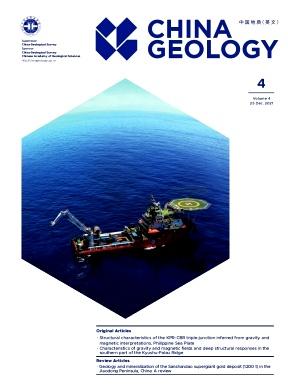Distributions and risk assessment of heavy metals in solid waste in lead-zinc mining areas and across the soil, water body, sediment and agricultural product ecosystem in their surrounding areas
IF 4.7
3区 地球科学
Q1 GEOSCIENCES, MULTIDISCIPLINARY
引用次数: 0
Abstract
To identify the root causes of heavy metal contamination in soils as well as prevent and control such contamination from its sources, this study explored the accumulation patterns and ecological risks of heavy metals like Cd and Pb in solid waste in mining areas and across the water body, sediment, soil and agricultural product ecosystem surrounding the mining areas. Focusing on the residual solid waste samples in lead-zinc deposits in a certain area of Guizhou Province, along with samples of topsoils, irrigation water, river sediments, and crops from surrounding areas. This study analyzed the distributions of eight heavy metals, i.e., Cd, As, Cr, Hg, Pb, Zn, Cu, and Ni, in the samples through field surveys and sample tests. Furthermore, this study assessed the contamination levels and ecological risks of heavy metals in soils, sediments, and agricultural products using methods such as the single-factor index, Nemerow composite index, and potential ecological risk assessment. The results indicate that heavy metals in the solid waste samples all exhibited concentrations exceeding their risk screening values, with 60% greater than their risk intervention values. The soils and sediments demonstrate slight and moderate comprehensive ecological risks of heavy metals. The single-factor potential ecological risks of heavy metals in both the soil and sediment samples decreased in the order of Hg, Cd, Pb, As, Cu, Zn, Cr, and Ni, suggesting the same sources of heavy metals in the soils and sediments. Most of the agricultural product samples exhibited over-limit concentrations of heavy metals dominated by Cd, Pb, Ni, and Cr, excluding Hg and As. The agricultural product assessment using the Nemerow composite index reveals that 35% of the agricultural product samples reached the heavy metal contamination level, implying that the agricultural products from farmland around the solid waste dumps have been contaminated with heavy metals. The eight heavy metals in the soil, sediment, and agricultural product samples manifested high coefficients of variation (CVs), indicating pronounced spatial variability. This suggests that their concentrations in soils, sediments, and agricultural products are significantly influenced by human mining activities. Additionally, the agricultural products exhibit strong transport and accumulation capacities for Cd, Cu, and Zn.
铅锌矿区固体废弃物及其周边土壤、水体、沉积物和农产品生态系统重金属分布及风险评价
为找出土壤重金属污染的根本原因,从源头上防治土壤重金属污染,本研究探讨了矿区固体废弃物以及矿区周边水体、沉积物、土壤和农产品生态系统中Cd、Pb等重金属的富集规律和生态风险。以贵州省某地区铅锌矿残留固体废弃物样品为研究对象,并结合周边地区表土、灌溉水、河流沉积物和农作物样品进行研究。本研究通过实地调查和样品测试,分析了样品中Cd、As、Cr、Hg、Pb、Zn、Cu、Ni 8种重金属的分布。采用单因素指数、Nemerow复合指数和潜在生态风险评价等方法,对土壤、沉积物和农产品中重金属的污染程度和生态风险进行了评价。结果表明,固体废物样品中重金属浓度均超过其风险筛查值,超过其风险干预值60%。土壤和沉积物呈现轻度和中度重金属综合生态风险。土壤和底泥中重金属单因素潜在生态风险大小依次为Hg、Cd、Pb、As、Cu、Zn、Cr、Ni,表明土壤和底泥中重金属来源相同。除Hg和As外,大部分农产品样品中重金属含量以Cd、Pb、Ni和Cr为主。利用Nemerow综合指数对农产品进行评价,35%的农产品样品达到重金属污染水平,表明固体废物堆场周边农田的农产品已经受到重金属污染。土壤、沉积物和农产品样品中8种重金属均表现出较高的变异系数(cv),表现出明显的空间变异。这表明它们在土壤、沉积物和农产品中的浓度受到人类采矿活动的显著影响。此外,农产品对Cd、Cu和Zn具有较强的转运和积累能力。
本文章由计算机程序翻译,如有差异,请以英文原文为准。
求助全文
约1分钟内获得全文
求助全文

 求助内容:
求助内容: 应助结果提醒方式:
应助结果提醒方式:


